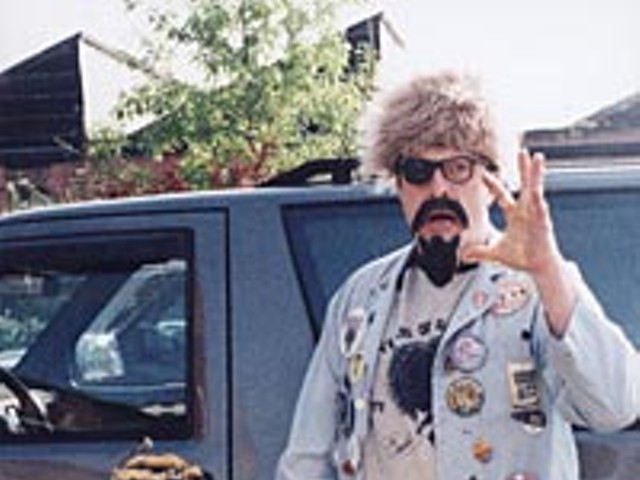Cartoon Network executives must be smirking. They’ve been smirking for quite some time, though it wasn’t until Friday night, Aug. 10, that their golden egg was revealed.
Enter “Samurai Jack,” a well-groomed, extraordinarily bold new project that dares to define the rough climate of animation today. Taking a brief glance at the show’s lead character, Jack, gives viewers an indelible impression. His eyes are focused, scorching with contempt. He is vengeance personified.
“I studied a lot of Kurosawa pictures. And also David Lean — especially for the environments, because I really wanted to make the environments a character and he’s so good at that, with Lawrence of Arabia with the desert and Dr. Zhivago with Russia. It was really amazing,” Genndy Tartakovsky, the creator of “Jack,” recalls. “I really love the way I felt when I watched those movies, because I love exploring new worlds and new lands.”
These aren’t words generally associated with the man responsible for Cartoon Network’s other smashes, the mischievous “Dexter’s Laboratory” and the lollipop farce, “The Powerpuff Girls.” But Tartakovsky’s goal for his new project is cinematic to the core — to shrink the dominance and energy of the silver-screen epic onto the 27-inch TV propped in your living room. So after years of toiling away at the conception board, katana-wielding Jack emerged.
The first episode opens with the young warrior witnessing the violent demise of his father at the hands of Aku, a sinister, shadow-born demon. Bitten by rancor, Jack escapes to be educated by the world with a solitary objective in mind — slaughtering the baneful, foreboding creature that swallowed his father’s soul. But to make things rather unpredictable, Jack is warped into the distant future seconds before achieving ultimate victory.
Alas, Aku fever is rampant in the Blade Runner-esque tar pit that is the dateless morrow. The demon’s trademarked image is plastered on cereal boxes, billboards and underwear. His dominance is superlative, his ego a choking, incendiary, self-righteous abyss.
Jack is lost in terrorland — conveniently cultivating the show in a futuristic landscape allowed for experimentation.
“Especially after doing ‘Dexter’s’ and ‘Powerpuff’ where [they are] quick-cutting, I definitely wanted to slow down the pacing a little bit,” Tartakovsky relates. “I wanted to take some time to develop things. Because they are half-hour episodes, we tried to do really, really simple stories. So instead of doing plot points, we can just do great eye candy and great visuals. We’ll have three minutes of an army marching, where before we would only do 10 seconds.”
So rather than concentrate on brief one-liners and goofy comedy, “Jack” jumps to the forefront of animated action shows. There are no superheroes wearing bubble gum-red tights. The only warrior is Jack, the dedicated, crafty swordsman from feudal Japan. Episode three (the last part of a 90-minute movie presentation) is entirely dedicated to the mashing of mechanical beetles. Twenty minutes, from start to finish, have our fearless samurai slicing “Johnny Quest”-type robots, utilizing his environment as a weapon. A nearby mine provides sharp crystal shards for a deadly pit of impalement; the jet engines of docked airships are the perfect tool to cook the robo insects — each and every trap playing an intricate role in the motivated, strategically plotted battle sequence. Jack, clad in wooden sandals and a white kimono, is a one-man war — a single body pitted against the Planet of the Apes.
Then couple his Crouching Tiger ballet of dicing and flailing with a stylized, techno-mixed soundtrack to complete the package: “Because we push the visuals so much, I definitely wanted the music to support it. I started listening to a lot of world DJs — a lot of international music — music from Morocco and Turkey and Spain and all these different places where DJs are bringing their culture into modern, techno and hip-hop music. I really liked that idea. Let’s say Jack enters a village and there’s some kind of weird aliens living there. We would base the aliens on an ancient culture, let’s say Morocco, for example. [Then] we would twist it so it would be future Moroccan. So when we do the music, we take the foundation of Moroccan music, but twist and put new instruments and backbeats to it so it sounds like a hip-hop version of belly-dancing music.”
Once sweetened and shrink-wrapped, “Jack” is a package that’s difficult to ignore. But considering that the show airs on Cartoon Network, a cable outlet with a demographic of pre-driver’s-license youth — and much, much younger — how can executives justify such an experimental, meditated-action riff?
“When adults make cartoons for kids, they pander to them. They dumb them down. They overexplain things. Like when somebody picks up a pen and they say, ‘Oh, I have to pick up this pen.’ It sounds silly, but it’s all over television. Kids are smart.”
So is Cartoon Network. It has 26 episodes of “Samurai Jack” percolating.
Jon M. Gibson had an accident playing with some very sharp "research" material. E-mail him at [email protected]




